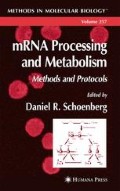Abstract
In cells, the poly(A) tail stimulates translation from messenger RNAs bearing a cap structure or viral IRES elements. This 3′ end-mediated stimulation of translation is not reflected in commonly used commercial cell-free translation systems prepared from rabbit reticulocytes or wheat germ. We describe a simple procedure to generate poly(A) tail-responsive translation extracts from HeLa cells. We suggest that this procedure should be adaptable to many animal cell lines.
Access this chapter
Tax calculation will be finalised at checkout
Purchases are for personal use only
References
Gallie, D. R. (1991) The cap and poly(A) tail function synergistically to regulate mRNA translational efficiency. Genes Dev. 5, 2108–2116.
Tarun, S. Z. Jr and Sachs, A. B. (1995) A common function for mRNA 5′ and 3′ ends in translation initiation in yeast. Genes Dev. 9, 2997–3007.
Sachs, A. B., Sarnow, P., and Hentze M. W. (1997) Starting at the beginning, middle, and end: translation initiation in eukaryotes. Cell 89, 831–838.
Preiss, T. and Hentze, M. W. (1998) Dual function of the messenger RNA cap structure in poly(A)-tail-promoted translation in yeast. Nature 392, 516–520.
Tarun, S. Z. Jr and Sachs, A. B. (1996) Association of the yeast poly(A) tail binding protein with translation initiation factor eIF-4G. EMBO J. 15, 7168–77.
Le, H., Tanguay, R. L., Balasta, M. L., Wie, C. C., Browning, K. S., Metz, A. M., Goss, D. J., and Gallie, D. R. (1997) Translation initiation factors eIF-iso4G and eIF-4B interact with the poly(A)-binding protein and increase its RNA binding activity. J. Biol. Chem. 272, 16247–16255.
Imataka, H., Gradi, A., and Sonenberg, N. (1998) A newly identified N-terminal amino acid sequence of human eIF4G binds poly(A)-binding protein and functions in poly(A)-dependent translation. EMBO J. 17, 7480–7489
Pelletier, J. and Sonenberg, N. (1988) Internal initiation of translation of eukaryotic mRNA directed by a sequence derived from poliovirus RNA. Nature 334, 320–325.
Jang, S. K., Krausslich, H. G., Nicklin, M. J., Duke, G. M., Palmenberg, A. C., and Wimmer, E. (1988) A segment of the 5′ nontranslated region of encephalomyocarditis virus RNA directs internal entry of ribosomes during in vitro translation. J. Virol. 62, 2636–2643.
Kaminski, A., Howell, M. T., and Jackson, R. J. (1990) Initiation of encephalomyocarditis virus RNA translation: the authentic initiation site is not selected by a scanning mechanism. EMBO J. 9, 3753–3759.
Kaminski, A., Belsham, G. J., and Jackson, R. J. (1994) Translation of encephalomyocarditis virus RNA: parameters influencing the selection of the internal initiation site. EMBO J. 13, 1673–1681.
Macejak, D. G. and Sarnow, P. (1991) Internal initiation of translation mediated by the 5′ leader of a cellular mRNA. Nature 353, 90–94.
Michel, Y. M., Poncet, D., Piron, M., Kean, K. M., and Borman, A. M. (2000) Cap-Poly(A) synergy in mammalian cell-free extracts. Investigation of the requirements for poly(A)-mediated stimulation of translation initiation. J. Biol. Chem. 275, 32,268–32,276.
Bergamini, G., Preiss, T., and Hentze, M. W. (2000) Picornavirus IRESes and the poly(A) tail jointly promote cap-independent translation in a mammalian cell-free system. RNA 6, 1781–1790.
Svitkin, Y. V., Imataka, H., Khaleghpour, K., Kahvejian, A., Liebig, H. D., and Sonenberg, N. (2001) Poly(A)-binding protein interaction with elF4G stimulates picornavirus IRES-dependent translation. RNA 7, 1743–1752.
Jackson, R. J. and Hunt, T. (1983) Preparation and use of nuclease-treated rabbit reticulocyte lysates for the translation of eukaryotic messenger RNA. Meth. Enzymol. 96, 50–74.
Both, G. W., Banerjee, A. K., and Shatkin, A. J. (1975) Methylation-dependent translation of viral messenger RNAs in vitro. Proc. Natl. Acad. Sci. USA 72, 1189–1193.
Iizuka, N., Najita, L., Franzusoff, A., and Sarnow, P. (1994) Cap-dependent and cap-independent translation by internal initiation of mRNAs in cell extracts prepared from Saccharomyces cerevisiae. Mol. Cell Biol. 14, 7322–7330.
Gebauer, F., Corona, D. F., Preiss, T., Becker, P. B., and Hentze, M. W. (1999) Translational control of dosage compensation in Drosophila by Sex-lethal: cooperative silencing via the 5′ and 3′ untranslated regions of msl-2 mRNA is independent of the poly(A) tail. EMBO J. 18, 6146–6154.
Stripecke, R. and Hentze, M. W. (1992) Bacteriophage and spliceosomal proteins function as position-dependent cis/trans repressors of mRNA translation in vitro. Nucleic Acids Res. 20, 5555–5564.
Author information
Authors and Affiliations
Editor information
Editors and Affiliations
Rights and permissions
Copyright information
© 2004 Humana Press Inc., Totowa, NJ
About this protocol
Cite this protocol
Thoma, C., Ostareck-Lederer, A., Hentze, M.W. (2004). A Poly(A) Tail-Responsive In Vitro System for Cap- or IRES-Driven Translation From HeLa Cells. In: Schoenberg, D.R. (eds) mRNA Processing and Metabolism. Methods in Molecular Biology™, vol 257. Humana Press. https://doi.org/10.1385/1-59259-750-5:171
Download citation
DOI: https://doi.org/10.1385/1-59259-750-5:171
Publisher Name: Humana Press
Print ISBN: 978-1-58829-225-4
Online ISBN: 978-1-59259-750-5
eBook Packages: Springer Protocols

